HI6006: In-Depth Analysis of Strategy Development Tools & Business Use
VerifiedAdded on 2023/06/14
|5
|1550
|297
Essay
AI Summary
This essay comprehensively explores strategy development tools, focusing on Porter's Five Forces, the Resource-Based View (RBV), and PESTLE analysis. It discusses how Porter's Five Forces analyzes market competition, using Woolworth as an example to illustrate the threat of substitutes and rivalry. The RBV is presented as a tool to analyze a company's competitive advantage through internal resources, exemplified by Toyota's success in quality and innovation. PESTLE analysis is explained as a method for evaluating macro-environmental factors, with Cadbury used to demonstrate the importance of political, economic, social, technological, legal, and environmental considerations. The essay emphasizes the importance of these tools in strategic decision-making and achieving a sustainable competitive advantage.
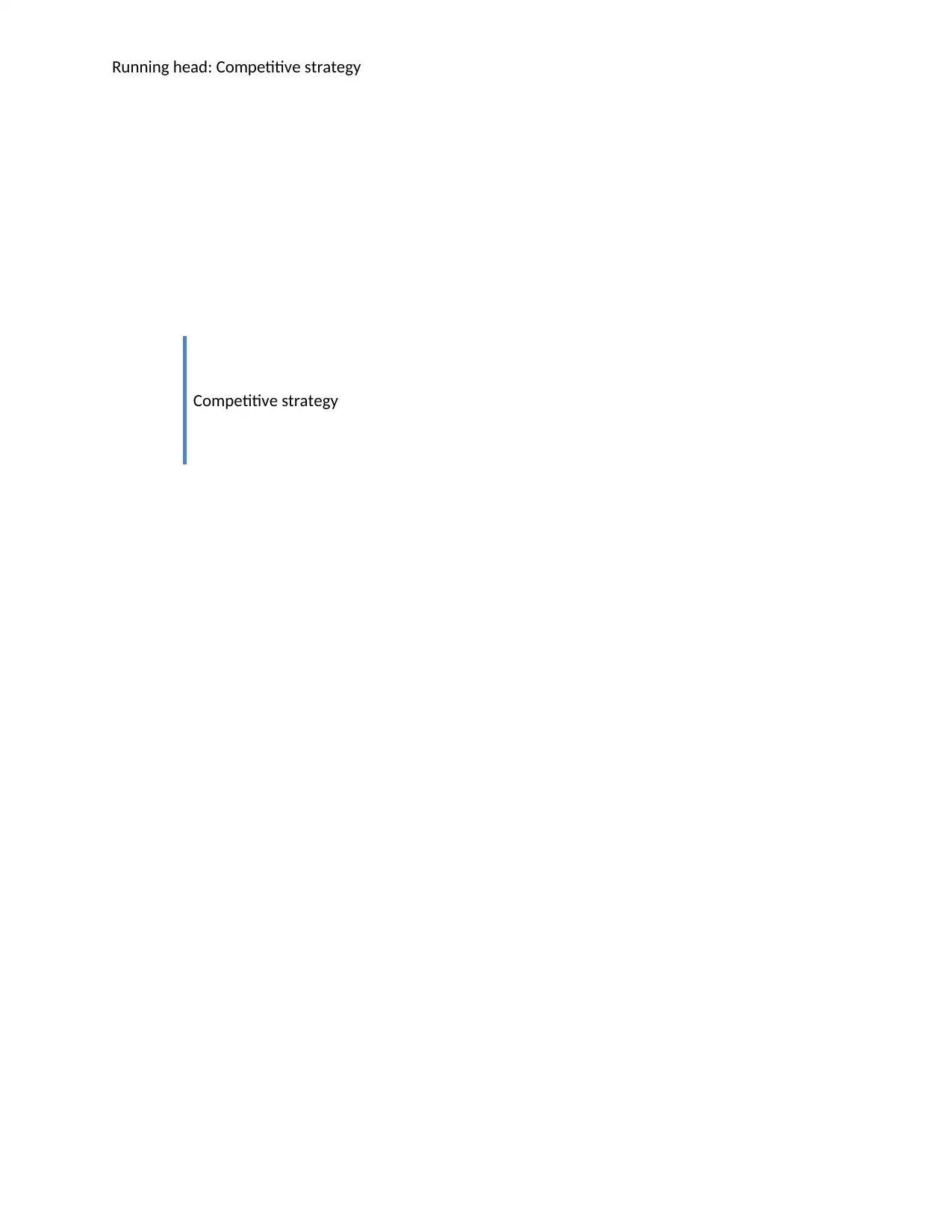
Running head: Competitive strategy
Competitive strategy
Competitive strategy
Paraphrase This Document
Need a fresh take? Get an instant paraphrase of this document with our AI Paraphraser
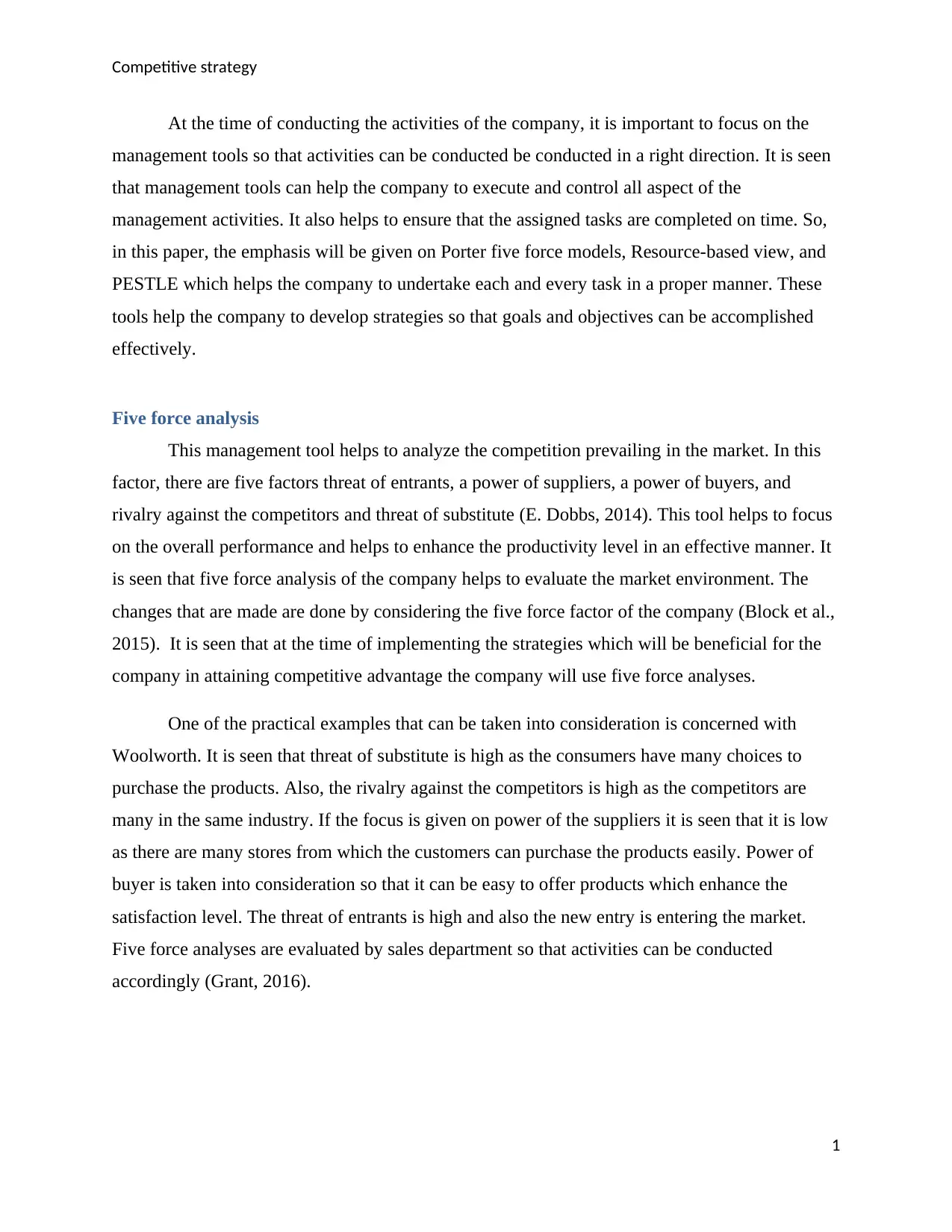
Competitive strategy
At the time of conducting the activities of the company, it is important to focus on the
management tools so that activities can be conducted be conducted in a right direction. It is seen
that management tools can help the company to execute and control all aspect of the
management activities. It also helps to ensure that the assigned tasks are completed on time. So,
in this paper, the emphasis will be given on Porter five force models, Resource-based view, and
PESTLE which helps the company to undertake each and every task in a proper manner. These
tools help the company to develop strategies so that goals and objectives can be accomplished
effectively.
Five force analysis
This management tool helps to analyze the competition prevailing in the market. In this
factor, there are five factors threat of entrants, a power of suppliers, a power of buyers, and
rivalry against the competitors and threat of substitute (E. Dobbs, 2014). This tool helps to focus
on the overall performance and helps to enhance the productivity level in an effective manner. It
is seen that five force analysis of the company helps to evaluate the market environment. The
changes that are made are done by considering the five force factor of the company (Block et al.,
2015). It is seen that at the time of implementing the strategies which will be beneficial for the
company in attaining competitive advantage the company will use five force analyses.
One of the practical examples that can be taken into consideration is concerned with
Woolworth. It is seen that threat of substitute is high as the consumers have many choices to
purchase the products. Also, the rivalry against the competitors is high as the competitors are
many in the same industry. If the focus is given on power of the suppliers it is seen that it is low
as there are many stores from which the customers can purchase the products easily. Power of
buyer is taken into consideration so that it can be easy to offer products which enhance the
satisfaction level. The threat of entrants is high and also the new entry is entering the market.
Five force analyses are evaluated by sales department so that activities can be conducted
accordingly (Grant, 2016).
1
At the time of conducting the activities of the company, it is important to focus on the
management tools so that activities can be conducted be conducted in a right direction. It is seen
that management tools can help the company to execute and control all aspect of the
management activities. It also helps to ensure that the assigned tasks are completed on time. So,
in this paper, the emphasis will be given on Porter five force models, Resource-based view, and
PESTLE which helps the company to undertake each and every task in a proper manner. These
tools help the company to develop strategies so that goals and objectives can be accomplished
effectively.
Five force analysis
This management tool helps to analyze the competition prevailing in the market. In this
factor, there are five factors threat of entrants, a power of suppliers, a power of buyers, and
rivalry against the competitors and threat of substitute (E. Dobbs, 2014). This tool helps to focus
on the overall performance and helps to enhance the productivity level in an effective manner. It
is seen that five force analysis of the company helps to evaluate the market environment. The
changes that are made are done by considering the five force factor of the company (Block et al.,
2015). It is seen that at the time of implementing the strategies which will be beneficial for the
company in attaining competitive advantage the company will use five force analyses.
One of the practical examples that can be taken into consideration is concerned with
Woolworth. It is seen that threat of substitute is high as the consumers have many choices to
purchase the products. Also, the rivalry against the competitors is high as the competitors are
many in the same industry. If the focus is given on power of the suppliers it is seen that it is low
as there are many stores from which the customers can purchase the products easily. Power of
buyer is taken into consideration so that it can be easy to offer products which enhance the
satisfaction level. The threat of entrants is high and also the new entry is entering the market.
Five force analyses are evaluated by sales department so that activities can be conducted
accordingly (Grant, 2016).
1
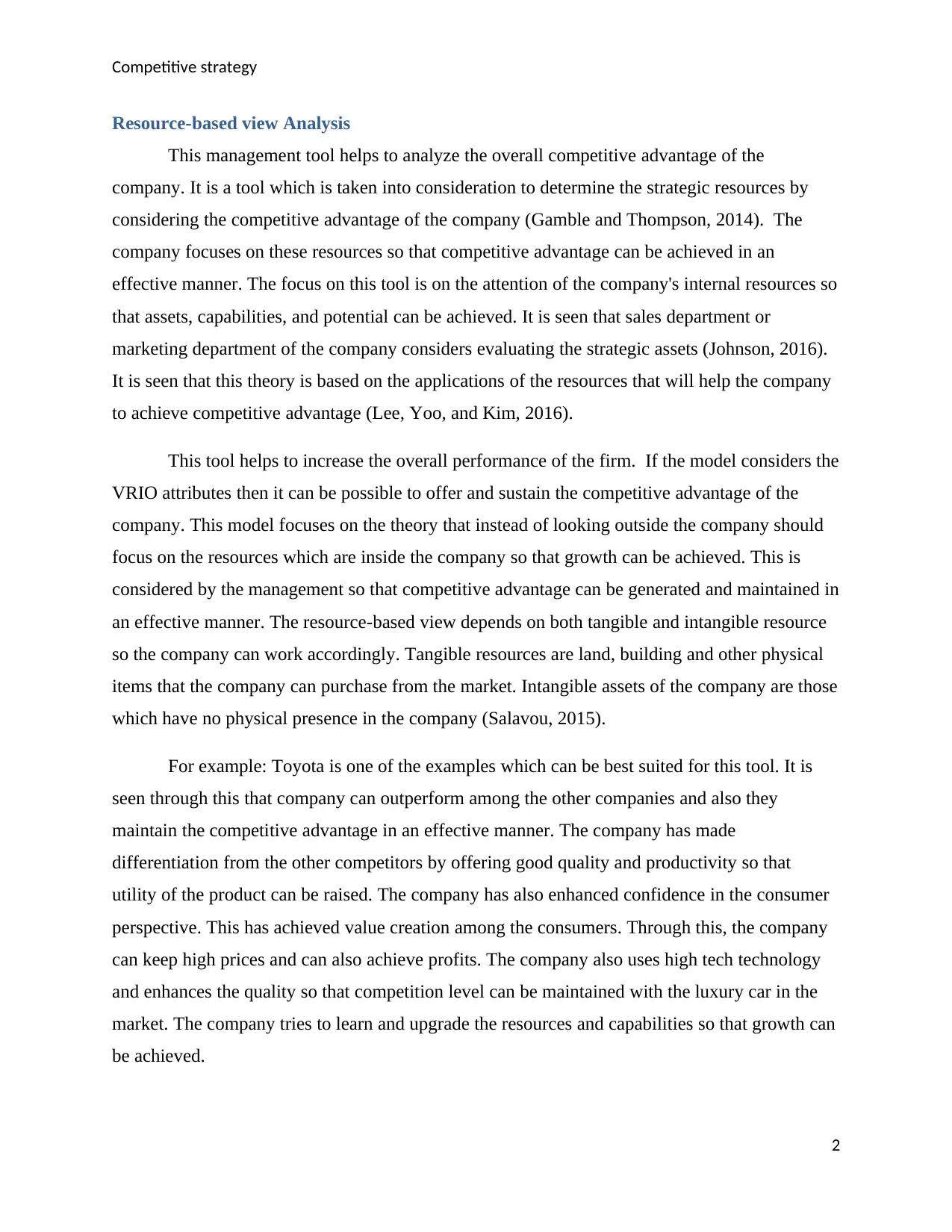
Competitive strategy
Resource-based view Analysis
This management tool helps to analyze the overall competitive advantage of the
company. It is a tool which is taken into consideration to determine the strategic resources by
considering the competitive advantage of the company (Gamble and Thompson, 2014). The
company focuses on these resources so that competitive advantage can be achieved in an
effective manner. The focus on this tool is on the attention of the company's internal resources so
that assets, capabilities, and potential can be achieved. It is seen that sales department or
marketing department of the company considers evaluating the strategic assets (Johnson, 2016).
It is seen that this theory is based on the applications of the resources that will help the company
to achieve competitive advantage (Lee, Yoo, and Kim, 2016).
This tool helps to increase the overall performance of the firm. If the model considers the
VRIO attributes then it can be possible to offer and sustain the competitive advantage of the
company. This model focuses on the theory that instead of looking outside the company should
focus on the resources which are inside the company so that growth can be achieved. This is
considered by the management so that competitive advantage can be generated and maintained in
an effective manner. The resource-based view depends on both tangible and intangible resource
so the company can work accordingly. Tangible resources are land, building and other physical
items that the company can purchase from the market. Intangible assets of the company are those
which have no physical presence in the company (Salavou, 2015).
For example: Toyota is one of the examples which can be best suited for this tool. It is
seen through this that company can outperform among the other companies and also they
maintain the competitive advantage in an effective manner. The company has made
differentiation from the other competitors by offering good quality and productivity so that
utility of the product can be raised. The company has also enhanced confidence in the consumer
perspective. This has achieved value creation among the consumers. Through this, the company
can keep high prices and can also achieve profits. The company also uses high tech technology
and enhances the quality so that competition level can be maintained with the luxury car in the
market. The company tries to learn and upgrade the resources and capabilities so that growth can
be achieved.
2
Resource-based view Analysis
This management tool helps to analyze the overall competitive advantage of the
company. It is a tool which is taken into consideration to determine the strategic resources by
considering the competitive advantage of the company (Gamble and Thompson, 2014). The
company focuses on these resources so that competitive advantage can be achieved in an
effective manner. The focus on this tool is on the attention of the company's internal resources so
that assets, capabilities, and potential can be achieved. It is seen that sales department or
marketing department of the company considers evaluating the strategic assets (Johnson, 2016).
It is seen that this theory is based on the applications of the resources that will help the company
to achieve competitive advantage (Lee, Yoo, and Kim, 2016).
This tool helps to increase the overall performance of the firm. If the model considers the
VRIO attributes then it can be possible to offer and sustain the competitive advantage of the
company. This model focuses on the theory that instead of looking outside the company should
focus on the resources which are inside the company so that growth can be achieved. This is
considered by the management so that competitive advantage can be generated and maintained in
an effective manner. The resource-based view depends on both tangible and intangible resource
so the company can work accordingly. Tangible resources are land, building and other physical
items that the company can purchase from the market. Intangible assets of the company are those
which have no physical presence in the company (Salavou, 2015).
For example: Toyota is one of the examples which can be best suited for this tool. It is
seen through this that company can outperform among the other companies and also they
maintain the competitive advantage in an effective manner. The company has made
differentiation from the other competitors by offering good quality and productivity so that
utility of the product can be raised. The company has also enhanced confidence in the consumer
perspective. This has achieved value creation among the consumers. Through this, the company
can keep high prices and can also achieve profits. The company also uses high tech technology
and enhances the quality so that competition level can be maintained with the luxury car in the
market. The company tries to learn and upgrade the resources and capabilities so that growth can
be achieved.
2
⊘ This is a preview!⊘
Do you want full access?
Subscribe today to unlock all pages.

Trusted by 1+ million students worldwide
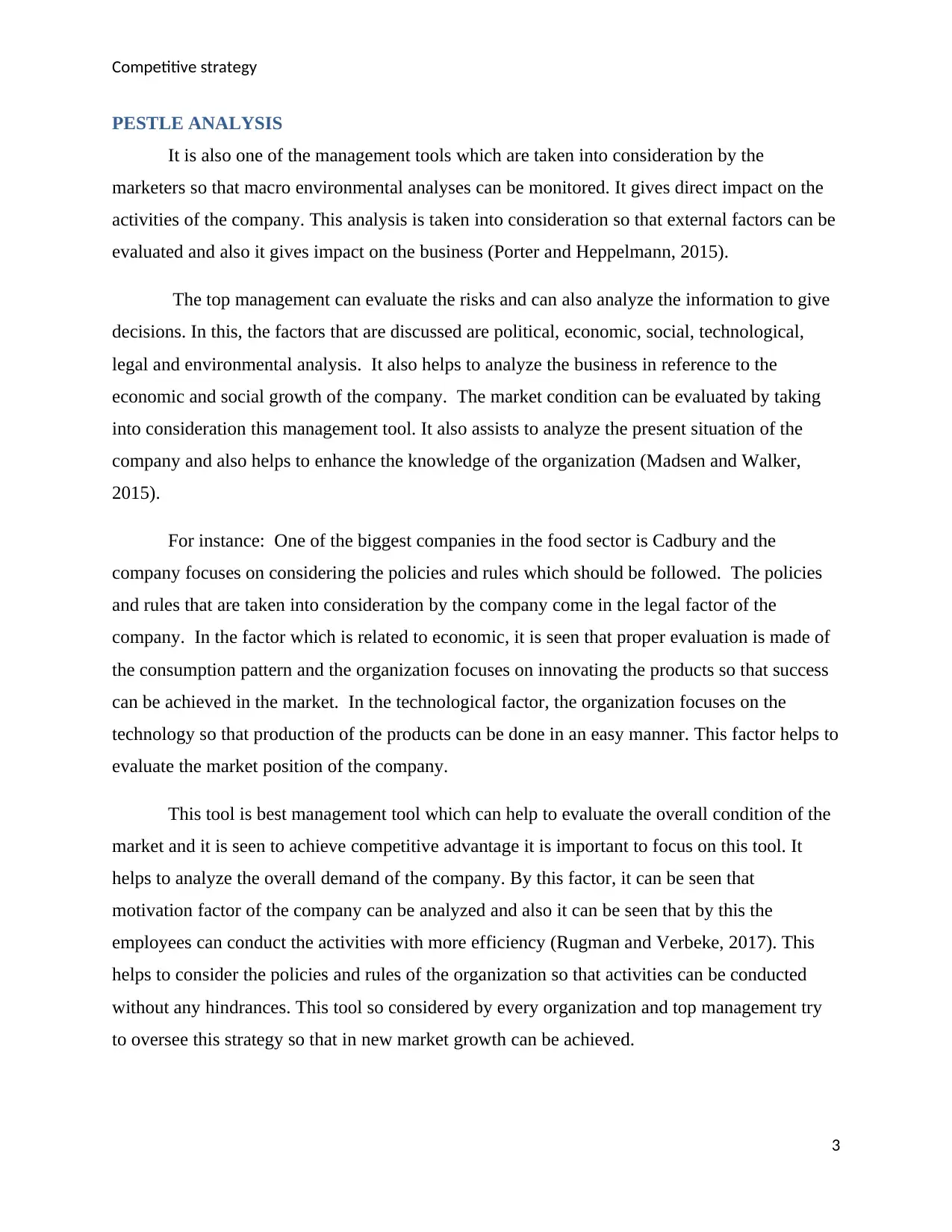
Competitive strategy
PESTLE ANALYSIS
It is also one of the management tools which are taken into consideration by the
marketers so that macro environmental analyses can be monitored. It gives direct impact on the
activities of the company. This analysis is taken into consideration so that external factors can be
evaluated and also it gives impact on the business (Porter and Heppelmann, 2015).
The top management can evaluate the risks and can also analyze the information to give
decisions. In this, the factors that are discussed are political, economic, social, technological,
legal and environmental analysis. It also helps to analyze the business in reference to the
economic and social growth of the company. The market condition can be evaluated by taking
into consideration this management tool. It also assists to analyze the present situation of the
company and also helps to enhance the knowledge of the organization (Madsen and Walker,
2015).
For instance: One of the biggest companies in the food sector is Cadbury and the
company focuses on considering the policies and rules which should be followed. The policies
and rules that are taken into consideration by the company come in the legal factor of the
company. In the factor which is related to economic, it is seen that proper evaluation is made of
the consumption pattern and the organization focuses on innovating the products so that success
can be achieved in the market. In the technological factor, the organization focuses on the
technology so that production of the products can be done in an easy manner. This factor helps to
evaluate the market position of the company.
This tool is best management tool which can help to evaluate the overall condition of the
market and it is seen to achieve competitive advantage it is important to focus on this tool. It
helps to analyze the overall demand of the company. By this factor, it can be seen that
motivation factor of the company can be analyzed and also it can be seen that by this the
employees can conduct the activities with more efficiency (Rugman and Verbeke, 2017). This
helps to consider the policies and rules of the organization so that activities can be conducted
without any hindrances. This tool so considered by every organization and top management try
to oversee this strategy so that in new market growth can be achieved.
3
PESTLE ANALYSIS
It is also one of the management tools which are taken into consideration by the
marketers so that macro environmental analyses can be monitored. It gives direct impact on the
activities of the company. This analysis is taken into consideration so that external factors can be
evaluated and also it gives impact on the business (Porter and Heppelmann, 2015).
The top management can evaluate the risks and can also analyze the information to give
decisions. In this, the factors that are discussed are political, economic, social, technological,
legal and environmental analysis. It also helps to analyze the business in reference to the
economic and social growth of the company. The market condition can be evaluated by taking
into consideration this management tool. It also assists to analyze the present situation of the
company and also helps to enhance the knowledge of the organization (Madsen and Walker,
2015).
For instance: One of the biggest companies in the food sector is Cadbury and the
company focuses on considering the policies and rules which should be followed. The policies
and rules that are taken into consideration by the company come in the legal factor of the
company. In the factor which is related to economic, it is seen that proper evaluation is made of
the consumption pattern and the organization focuses on innovating the products so that success
can be achieved in the market. In the technological factor, the organization focuses on the
technology so that production of the products can be done in an easy manner. This factor helps to
evaluate the market position of the company.
This tool is best management tool which can help to evaluate the overall condition of the
market and it is seen to achieve competitive advantage it is important to focus on this tool. It
helps to analyze the overall demand of the company. By this factor, it can be seen that
motivation factor of the company can be analyzed and also it can be seen that by this the
employees can conduct the activities with more efficiency (Rugman and Verbeke, 2017). This
helps to consider the policies and rules of the organization so that activities can be conducted
without any hindrances. This tool so considered by every organization and top management try
to oversee this strategy so that in new market growth can be achieved.
3
Paraphrase This Document
Need a fresh take? Get an instant paraphrase of this document with our AI Paraphraser
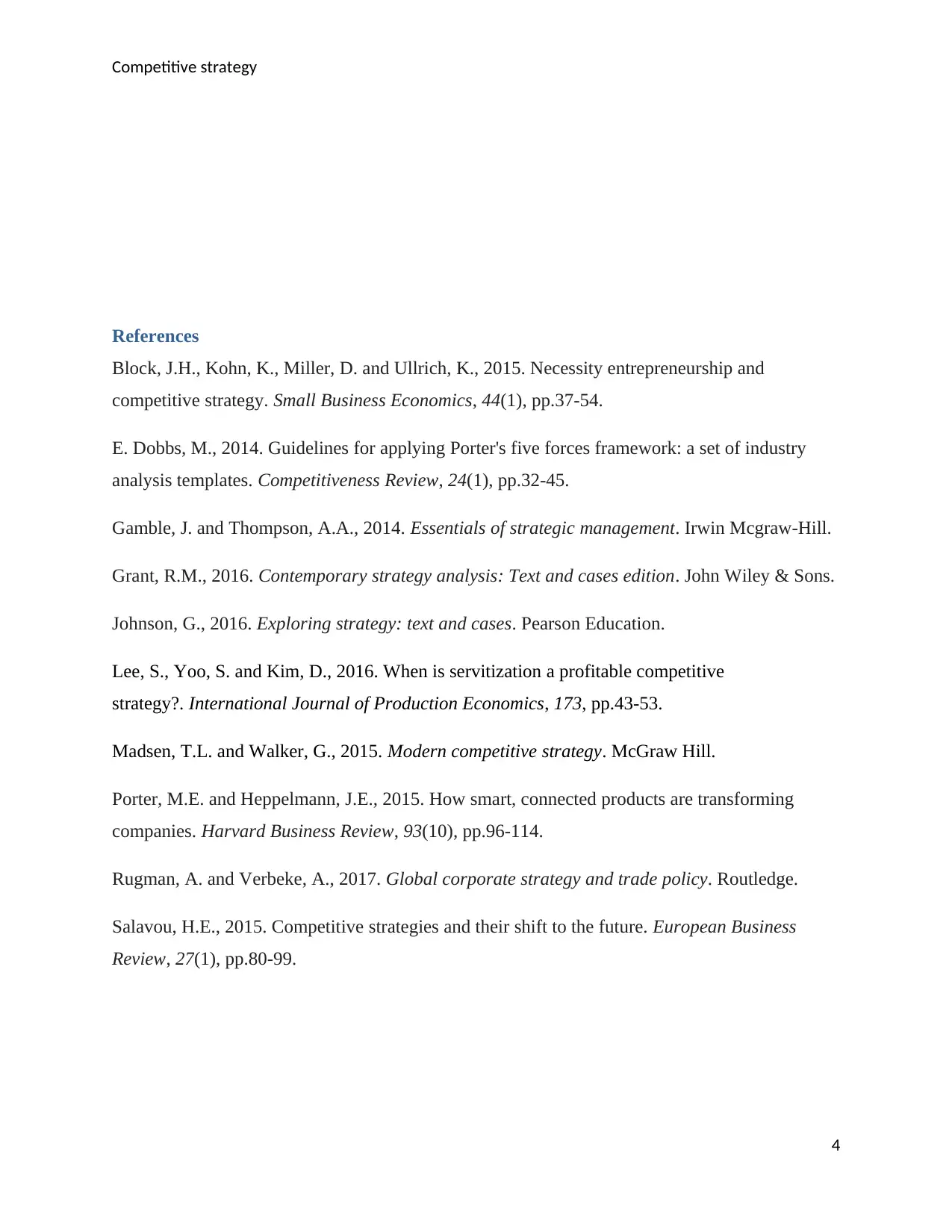
Competitive strategy
References
Block, J.H., Kohn, K., Miller, D. and Ullrich, K., 2015. Necessity entrepreneurship and
competitive strategy. Small Business Economics, 44(1), pp.37-54.
E. Dobbs, M., 2014. Guidelines for applying Porter's five forces framework: a set of industry
analysis templates. Competitiveness Review, 24(1), pp.32-45.
Gamble, J. and Thompson, A.A., 2014. Essentials of strategic management. Irwin Mcgraw-Hill.
Grant, R.M., 2016. Contemporary strategy analysis: Text and cases edition. John Wiley & Sons.
Johnson, G., 2016. Exploring strategy: text and cases. Pearson Education.
Lee, S., Yoo, S. and Kim, D., 2016. When is servitization a profitable competitive
strategy?. International Journal of Production Economics, 173, pp.43-53.
Madsen, T.L. and Walker, G., 2015. Modern competitive strategy. McGraw Hill.
Porter, M.E. and Heppelmann, J.E., 2015. How smart, connected products are transforming
companies. Harvard Business Review, 93(10), pp.96-114.
Rugman, A. and Verbeke, A., 2017. Global corporate strategy and trade policy. Routledge.
Salavou, H.E., 2015. Competitive strategies and their shift to the future. European Business
Review, 27(1), pp.80-99.
4
References
Block, J.H., Kohn, K., Miller, D. and Ullrich, K., 2015. Necessity entrepreneurship and
competitive strategy. Small Business Economics, 44(1), pp.37-54.
E. Dobbs, M., 2014. Guidelines for applying Porter's five forces framework: a set of industry
analysis templates. Competitiveness Review, 24(1), pp.32-45.
Gamble, J. and Thompson, A.A., 2014. Essentials of strategic management. Irwin Mcgraw-Hill.
Grant, R.M., 2016. Contemporary strategy analysis: Text and cases edition. John Wiley & Sons.
Johnson, G., 2016. Exploring strategy: text and cases. Pearson Education.
Lee, S., Yoo, S. and Kim, D., 2016. When is servitization a profitable competitive
strategy?. International Journal of Production Economics, 173, pp.43-53.
Madsen, T.L. and Walker, G., 2015. Modern competitive strategy. McGraw Hill.
Porter, M.E. and Heppelmann, J.E., 2015. How smart, connected products are transforming
companies. Harvard Business Review, 93(10), pp.96-114.
Rugman, A. and Verbeke, A., 2017. Global corporate strategy and trade policy. Routledge.
Salavou, H.E., 2015. Competitive strategies and their shift to the future. European Business
Review, 27(1), pp.80-99.
4
1 out of 5
Related Documents
Your All-in-One AI-Powered Toolkit for Academic Success.
+13062052269
info@desklib.com
Available 24*7 on WhatsApp / Email
![[object Object]](/_next/static/media/star-bottom.7253800d.svg)
Unlock your academic potential
Copyright © 2020–2025 A2Z Services. All Rights Reserved. Developed and managed by ZUCOL.


